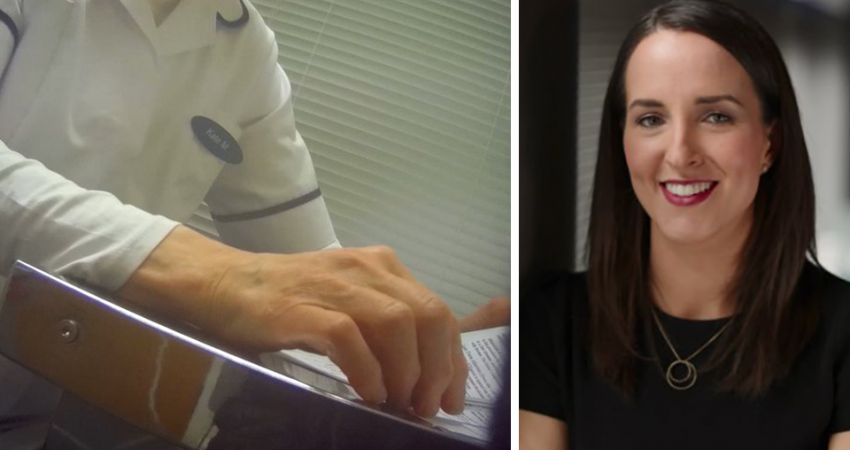
RTÉ Investigates turns a blind eye to 38,000 babies aborted and other grim realities
In my experience, any programme emanating from RTÉ looking at abortion is always likely to be biased - and, since repeal, it is also now likely to push a narrative that seeks to widen the existing law even further. However, even with those low expectations, Monday's documentary from RTÉ Investigates was astonishingly, deplorably, remarkably, one-sided and unfair.
In truth, since the referendum in 2018, it's very rare to hear a pro-life voice on our taxpayer-funded station. Most airtime on the issue is instead given to cooing at the National Women's Council in syrupy, softball interviews which avoid uncomfortable truths such as our rocketing abortion rates, or the tragic and profoundly dangerous mistakes being made in abortion provision.
Instead, the national station is broadcasting a steady drumbeat demanding that we open up life-ending abortion services even further.
So the latest production by RTÉ was always going to be, as one observer noted on X, a hit piece on the most defenceless. The was predictable. That doesn't mean it was acceptable.
"RTÉ Investigates the realities of Ireland's current abortion services," the station proclaimed in its descriptor of the programme - and, as she walked around Dublin Castle in its introduction, reporter Aoife Hegarty intoned that the review would not examine the "rights or wrongs of abortion".
That was all sort of half-true. There was almost an hour given to abortion 'rights': but no investigation at all of most of the horrific wrongs - the reality of much of what's happening around abortion in Ireland.
A blind eye was turned to even the latest alarming outcome where a woman almost died after an abortion in Limerick - and the piece certainly did not make any attempt to examine the many negative aspects of abortion provision. Those realties were left uninvestigated.
For days beforehand, RTÉ was running promos on, eh, RTÉ, advertising the documentary, while current affairs programmes like Morning Ireland and News at One did their bit to stoke up views by interviewing Ministers or solemnly previewing what was billed as a look at the "stark reality" of Ireland's abortion services.
Except it wasn't. The 'stark reality' was mostly avoided. This documentary was dishonest and manipulative and horribly one-sided. And yes, I know I'm a pro-lifer, and therefore an advocate of that position that is one of RTÉ's favourite punching bags (along with the belief that biological sex is real, or that open borders are a mistake) but those are the most polite descriptors I can think of, to be honest.
For most of the programme, the bias in favor of abortion was open and and obvious and brazen: there was no attempt to make the film in any way fair or balanced, or to explore the idea that maybe, just maybe, abortion mightn't always be an entirely positive thing - or that maybe, just maybe, 10,000 unborn babies killed and discarded before birth in just one year alone shouldn't give us pause.
Instead, from the outset, solemn music, and the use of words like 'forced' and "denied" and "abortion care", were employed to create a narrative that abortion is often the only option available to women.
In fact, one of the opening scenes in the programme shows a woman calling the Positive Options service offered by the Department for Health. Yet she never hears about any options. She is ONLY offered an abortion. Where is the choice in that?
Quite the start to #rteinvestigates.
— David W. Higgins (@higginsdavidw) April 15, 2024
A simulated phone call between the HSE and someone at 14 weeks.
The framing is very clear.
This isn't a push to alter the 3-day wait and FFA cases.
It's a push for full UK alignment.
Not all YES voters support this. pic.twitter.com/OkbWfcM1ci
Similarly, the personal stories around difficult diagnoses for unborn babies are undoubtedly heartbreaking, but what about the reality that there is another option than abortion in that instance too? Why wasn't that explored? Why didn't RTÉ acknowledge that when parents in this situation can access the right support, continuing to love and cherish their baby until birth can be enormously rewarding and comforting - as well as a bridge to healing after such a terrible loss?
Research showing that continuing with the pregnancy where baby has a life-limiting condition can be of benefit to women - with at least one study showing that, after a diagnosis of anencephaly, women who terminated reported "significantly more despair" than women who continued the pregnancy - wasn't even discussed
The documentary was deliberately coy in its reporting around the reality of the late-term abortions, using terms like 'termination' and 'stillborn'- although it sought to broaden the circumstances where the procedure can be carried out here. In reality, a feticide is carried out, where a lethal injection of potassium chloride is administered to the baby's heart. A paper from UCC published in the British Journal of Obstetrics and Gynaecology included quotes from doctors in Ireland carrying out these late-term abortions, and describing them as “‘brutal’, ‘awful’ and ‘emotionally difficult’ - and as ‘stabbing the baby in the heart’.
RTÉ might want to shrink from that reality, but keeping the truth from women actually doesn't offer them a full and informed choice. That's a key aspect of what's actually paternalistic and cruel about the system, not asking women to think about a decision they might feel pushed into.
And where was the acknowledgment that the deeply shocking case of Baby Christopher, where the State was brought to court by parents who did feel pushed towards abortion after a diagnosis - mistaken as it turned out - of Trisomy 18. A real investigation would have examined what has gone wrong in the culture in Irish maternity hospitals to cause such a devastating and life-ending mistake to happen just three months after abortion was legalised here.
There's also the undeniable fact that the changes to the abortion law RTÉ were seeking would usher in broader grounds for abortion in regard to babies with disabilities.
The most recent statistics from the British Department of Health clearly show that most Irish parents who seek an abortion after a diagnosis of a life-limiting condition now have an abortion in Ireland - since they are no being longer showing up in any significant numbers in the British data. It also shows another deeply saddening and shocking trend.
The British statistics show that the number of abortions carried out on women travelling from Ireland to England and Wales because the baby has Down syndrome has tripled between 2018 and 2021 - with a 3.7 fold jump in the number of Down syndrome abortions in that period. In fact, Dr Fergal Malone of the Rotunda has said that 95% of babies now diagnosed with Down syndrome in the hospital go on to be aborted.
Did RTÉ look at those statistics? Would that have been beyond their 'investigative' capabilities? Or was that just another inconvenient truth to be ignored?
Instead, there was a strong and blatant drumbeat right throughout the documentary for changes to the law, including the scrapping of the 3-day period of refection before abortion - a measure, which, according to figures released to Carol Nolan TD, likely leads to some 1,000 women every year changing their mind or not going through with an abortion.
Yet the RTÉ film saw the 3-day wait described as "cruel", They didn't bother speaking to Deputy Nolan or to any pro-life TD or pro-life doctor, or to a woman who had changed her mind during the wait. They had that in common, of course, with Marie O'Shea, the chair of the Abortion Review, who in an appearance before the Oireachtas Health Committee admitted that she hadn't spoken to one woman who had decided against abortion in that time of reflection.
RTÉ said the production team spent 7 months on this 'investigation'. They cannot be serious. Where was the thoughtful and comprehensive analysis of the impact of the law? Where was the deep dive into the possible coercion of women to undergo abortion? What about a look at the social reasons for - and negative effects of - the steep rise in the number of abortions? What about any attempt at a discussion of the deeply concerning abortion trends rather than another nodding heads fest where the same lame pro-abortion talking points were re-aired and re-broadcast.
Seven months - funded by you and me - on what was effectively a campaigning video. I suppose they got an "exclusive" interview with Marie O'Shea so that she could reiterate her claims that what Ireland needed was the 'courage' to widen our laws further and increase access. Because 10,000 abortions a year isn't enough? What is? 15,000? 20,000? A limitless number?
The real courage, of course, is displayed by those ordinary women and families who give their children the gift of life despite a society which pretends to be pro-choice but is really just telling women that that 'choice' means they're on their own.
And then, for all the talk about choice and freedom, the programme also contained a strong pitch for abortion zones, which would jail and otherwise punish people for even praying silently at an abortion centre. Their was a real smack of vindictiveness in that section of what was aired.
I wrote to Aoife Hegarty in RTÉ last week to ask the following questions about the programme:
1. Does the piece investigate the possible reasons for the sharp rise in the number of abortions now taking place?
2. Does it examine whether parents who have received a diagnosis of disability for their unborn child feel they may be being nudged towards abortion - as happened in the Baby Christopher case?
3. Is the case written up in the Irish Medical Journal in March discussed in your investigation - and the fact that doctors have warned that failing to provide an ultrasound before prescribing abortion pills may lead to women dying?
4. Does the piece examine the difficulties with late-term abortion provision - as outlined in the Abortion Review - where babies survive abortion and doctors struggle to get the assistance they need in that instance to provide care?
5. The tone of the [promotional] clip posted [on social media] seems to point to a report which leans towards the case for further liberalisation of the law. Is that a fair comment?
I received a media release in response which said the documentary was examining "the realities of Ireland's current abortion services as many are still forced to travel abroad."
Right then. A great sweeping under the carpet of any of the awfulness and sadness and cruelty and broken bodies produced by the abortion regime. Heads firmly in the sand about the near-death of a woman after abortion in Limerick. Nothing to see regarding late-term abortion and babies surviving the ghastly procedure. A steadfast refusal to examine the inconvenient truth that the promise abortion being "rare" has been smashed to pieces. Ignoring the fact that 38,000 abortions took place in just 5 years, but insisting the real issue is access.
RTÉ, as ever, is busy ignoring all the abortion elephants in the room, crashing about and breaking the furniture and creating a clamour which, for the ordinary person, is becoming just too disruptive to ignore.
At one point in the documentary, an abortion advocate receiving sympathetic coverage for her role in abortion provision is seen typing into a laptop. It bears a sticker boasting: "I use abortion as birth control". No hard questions asked about that stance by RTÉ either - but it shows how deeply out of sync with public opinion these people actually are, and how the supposed public service broadcaster's bias is shown as much by omission as anything else.
Have they learned nothing from the Tubridy fallout and other recent shocks to the system? The climate is changing. Many TDs who would have rushed to obey the demands of O'Shea and the National Women's Council are now still reeling in shock at the double NO vote in March - the landslide rejection of Official Ireland's view of what society should be.
RTÉ are slow on the uptake, it seems. They're still dressing up biased reporting as investigation, and campaigning as fair reporting. No wonder fewer and fewer people are listening to them.
Niamh Uí Bhriain
This was first published on gript and is printed here with permission
Featured
- RTÉ Investigates turns a blind eye to 38,000 babies aborted and other grim realities
- After Limerick case, medics write to every TD to warn ultrasounds must be provided before abortion
- Irish MEPs join EU lawmakers in voting to enshrine abortion as a fundamental right
- Every TD and Senator contacted re Limerick abortion scandal
- Stop the Cover-Up or Women Will Die
- "A testament to society's failure": 7681 abortions carried out in North of Ireland since 2020
- The west cannot take ‘human dignity’ for granted
- Horror in Prague: A hospital aborted the baby of the wrong mother
- Why are the media ignoring the abortion scandal that almost killed a woman?
- Limerick: woman who was prescribed abortion pills had life-threatening ectopic pregnancy
- Rally for Life 2024
- Exposing the Numbers
- Alive and Kicking: Your baby before 12 weeks


























